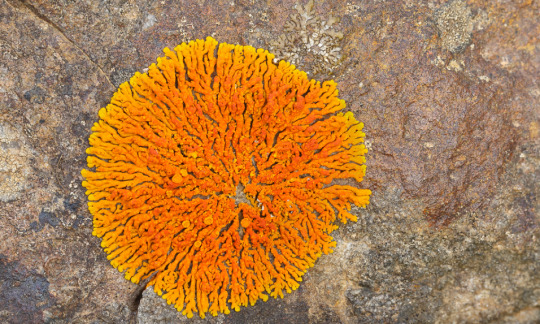#xanthoria candelaria
Text



Lichens by Chris Mattison
Top: Xanthoria elegans (orange), X. candelaria (yellow), Rhizoplace spp. (grey) and several others
Middle: Xanthoria parietina
Bottom: Xanthoria elegans
#xanthoria#xanthoria elegans#xanthoria candelaria#xanthoria parietina#rhizoplace#lichen#orange#colorful lichen#yellow#rocks#nature
34 notes
·
View notes
Note
You've talked about identifying lichens in class before on this blog, but if you don't mind me asking, how do you do that? How do you (or I guess how did you specifically) identify the lads?? I'm not asking for a tutorial on identifying lichens on my own btw, I'm just really curious on how exactly you went about it? I'm rlly new to botany so sorry if the answer is obvious !
okay, so this is something i didn’t know until i hit college, but biologists of all kinds usually identify things using something called a dichotomous key, which is kind of like a choose your own adventure/process of elimination thing. it’s a guide that has statements in numbered pairs, and as you pick which statement best represents the organism you’re trying to identify you’re pointed towards other pairs, which eventually lead you to either 1. the name of your species or 2. another, more specific key that will ask you more questions about your subject.
keys can be as general as a continent or as specific as a county, and they vary widely based on what the key is meant to identify, too, but the big one used in north america is Brodo’s ‘Lichens of North America’, which has been hugely influential in reviving modern lichenology since it came out in 2001. it’s also a required textbook in my uni’s lichen course. although this version has the keys, there’s an expanded and revised spiral bound version containing only the keys that’s way more affordable; my uni’s herbarium has both versions on hand, and when i identify The Lads in there i usually use the version with just the keys to narrow down a species, then look it up in the full textbook. unfortunately, the full textbook is an ENORMOUS (beautiful!! well illustrated!! detailed in species info and general biology!! but enormous) coffee table book and i left it in my hometown for this semester bc Lichen Teaching Time is primarily in spring.
because i don’t have my book with me, i’m gonna take some examples from the arguably second best lichen key source and one that’s coincidentally free to download online: Bruce Ryan’s Working Keys to Lichens of North America (note Brodo’s endorsement at the top of the page, lmao). note that in terms of practicality, Ryan’s keys are a bit out of date, but it’s a good example.
a key like this has to give us a place to start, so the ‘synopsis��� file when you expand the .zip is the first key that we’ll run our species through, and it’ll guide us to which key to go to from there; in an actual physical lichen key, this key will be the first one in the book. for the purposes of this, im gonna imagine i’m trying to identify the (common where i live) species Xanthoria candelaria, which is pretty distinctive from the fact that most things in the Xanthoria lichen genus are like, bright orange or yellow:

okay. so. here’s the first page.

so right away we have our first pair. if we take a sample from our lichen and put it under a microscope, and the algae we see is a blue-green color, it’s a lichen that has a cyanobacteria symbiont instead of a normal green algae symbiont, so it’s pretty easily narrowed down within the category of ‘Lads With Strange Inner Lads’ and therefore sends us to the cyanolichen key. Xanthoria has a normal green algae symbiont, so we’re directed to the second pair, where we’re asked about the growth form of the lichen. this lichen has the foliose growth form (kind of off the shits, but also pretty restrained), so we’re on to the third pair.

aaannd we hit our first redirect to a separate, more specific key; our lichen is foliose, which leads us to the fourth pair, which leads us to the foliose key. so far, pretty simple. unfortunately, depending on what you’re working with, things can tend to get pretty spicy after the main key; like, the farthest i’ve ever gotten lost in a key like this was probably around 150-170(?) pairs in, and that was with a really ambiguous lichen that i kept hitting dead ends with (kept getting redirected to a slew of wrong species on). easy identifications usually take me like, 15 minutes, while the hardest ones (like the 150 pair multiple-key monstrosity) can take me up to four hours or more. it really varies.
so like, for a technical key like this it helps to have a grasp on the vocab around the organisms you’re trying to identify, BUT there ARE a bunch of ID sites you can find online that use the same concept in a waaayyy more accessible way, like the gobotany general plant key here. like, i’m good with lichens, but for most plants i don’t think i’d be able to go like, full-on scientific dichotomous key like that. anyway thats probably more of an in-depth explanation than u wanted but yeah lmao
#long once again.......#but anyway yeah this is a really useful skill to have if ur like into that#or bio in general#plont asks#asks#lichens#Anonymous
257 notes
·
View notes